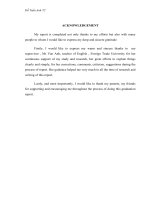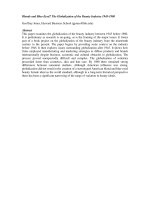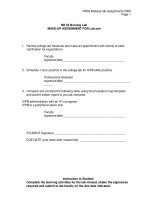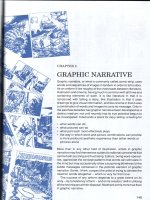Drawing Pencil Sketches For Better Art doc
Bạn đang xem bản rút gọn của tài liệu. Xem và tải ngay bản đầy đủ của tài liệu tại đây (100.17 KB, 6 trang )
Drawing Pencil Sketches For
Better Art
Drawing pencil sketches or thumbnails may seem boring and tedious, or you may
fully enjoy it, depending upon what the sketches are for and if you HAVE to do
them. In any case, planning your projects with pencil sketches will greatly
improve your end results.
Sketching out ideas or even just jotting down some ideas on your pages will
greatly increase the number of your drawings and help you realize the full
potential of the ideas or concepts you are trying to get across.
Drawing pencil sketches or thumbnails
of your concept before committing to a final design will always lead to a more
complete and thought out design
Think of drawing pencil sketches as drawing a storyboard of ideas. When you
create a storyboard of your ideas, it allows you to see what works and what
doesn't. It's a great method of brainstorming every aspect of the design before it is
finalized. It will hopefully lead to an even stronger design or concept than you first
imagined.
Drawing pencil sketches of the composition will allow you to tweak and plan a
stronger piece.
That last sentence is pure fact. Even if you draw 30 sketches for the one piece you
are working on and you think the first one is the best, you will absolutely know
that it is when you are done. Working out your composition quickly in twenty
different sketches is also a lot better use of time than spending hours finishing an
entire piece and then not being happy with the outcome. There is nothing worse
than wishing you would have rethought an element of the design after spending
hours to complete it. I have done this. As the old saying goes "anything worth
doing is worth doing right." So why skip and cut corners on your art?
Pencil sketching is great for getting all of the ideas out of your head quickly. They
don't need to be overly detailed or even finished works. That is the whole reason
for creating the sketches in the first place.
Drawing pencil sketches and doing a lot of
planning for my pieces was never really part of my process.
It does take a little extra effort and work to get into the habit of doing the sketches
and preplanning for pieces if you have never done it before. Once you do, you will
see why it is more beneficial to work this way.
Tip: It is infinitely better to work out all of the issues with design and composition
in pencil and paper before wasting time and effort as well as quality supplies on a
design that has not be fully realized. Also when drawing pencil sketches, it is
better to use a softer lead. A softer lead such as HB up to 8B is ideal.
A softer lead helps to record tone and line quickly when you are sketching out
those ideas that are flooding through you. The most important objective of
creating the sketches is to get the general idea or mood down and work out
perspective, lighting etc. Most sketches will not be fully detailed anyway. You can
always write in any notes you may think of afterward. The sketches will also help
you learn to use line more effectively and build confidence when working on
bigger pieces. Drawing pencil sketches also opens the door for more creative
design. After exhausting your initial design concepts and drawing ideas the
creative juices will have no other choice but to flow.
When I start a piece, I think of the initial ideas that I had floating around in my
head and then spiral outward from there. I don't always consciously do this, and
actually most of the time my mind just wanders all over, branching out into all
sorts of new ideas. Capturing those gems can be crucial, especially if you have a
horrible memory.
Keeping a sketchbook should be at the top of your list if you are serious at all
about your art.
You don't need to fill every page with
fully realized and frameable artwork. In fact sometimes just writing down what
you are thinking can help you think about the idea more fully later one.
Drawing pencil sketches will help you develop your drawing skills as well. If you
keep a sketchbook to record your ideas you will learn how to get your ideas down
quickly, which may not be easy at first. Sometimes many of my own sketches are
just jumbles of lines that look like they were done by a drunken kindergartner in
the dark. This may be due to actually waking up in the dark at night and drawing
them in the sketchbook next to my bed, but nonetheless the pencil sketches still
help me realize the ideas when I am more fully conscious.
The Bottom Line
Preplanning is a crucial, if not the most crucial, part of creating the most
compelling images you can. Keeping a sketchbook and creating pencil sketches of
your designs and even just sketching regularly will greatly improve your speed
and drawing skills and allow you to effectively get your ideas down onto paper.
Drawing pencil sketches of the different possible compostions will exponentially
improve your final pieces. Being able to see every different scenario of a piece by
varying the focal point, the value and tone, the style, or the use of line will allow
you to see what works and what doesn't. Think of building a house: It takes lots of
planning and reworking before you have a final blueprint.
The pencil sketches are the trials to your most fully realized and compete
blueprint. You can add to or tweak the blueprint as you go, but you will have
already put in the work of designing a solid base to work from that will allow for
the changes.









